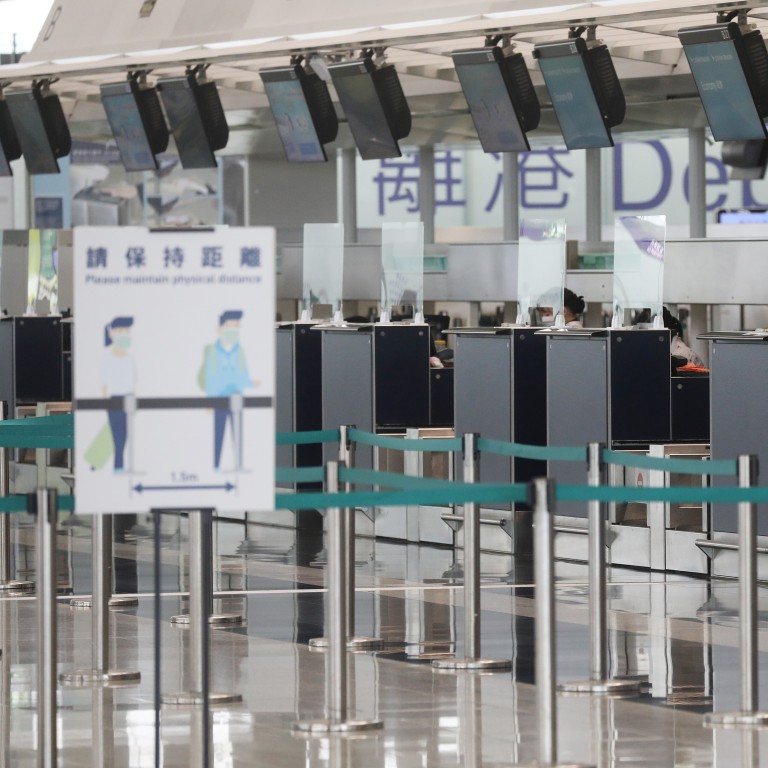
Cathay Pacific will tap government fund to help pay 27,000 employees in Hong Kong
- Airline also warns of ‘substantially reduced’ capacity over the summer
- Carrier is still waiting for government to lift travel restrictions and quarantine measures
The airline also revealed on Friday it would increase passenger flights in July to the highest level in four months, but the number would still fall below 10 per cent of its regular service before the pandemic hit.
The carrier’s revenue evaporated as Covid-19 brought global travel to a halt, taking the company to the brink of collapse before the Hong Kong government agreed to provide a massive bailout.
“After careful consideration the Cathay Pacific Group of companies have made an application [for the wage scheme] today,” the airline said. The first phase of the subsidy rune June to August.
The airline had 33,000 employees but more than 27,000 work in Hong Kong and would be eligible for the subsidy, sources said.

01:29
Hong Kong government to bail out Cathay Pacific with HK$30 billion in loans and direct stake
The government announced in March an HK$80 billion (US$10.32 billion) scheme to help employers ride out the Covid-19 by covering the cost of wages, contributing a maximum of HK$9,000 (US$1,160) a month per employee for six months up to the end of November this year.
One of the key conditions of the scheme is employers can not make redundancies during the scheme’s period. Cathay spent HK$20.1 billion on salaries last year, accounting for a fifth of expenses.
Amber Suen Tak-yin, vice-chair of the Cathay Pacific Flight Attendants’ Union, welcomed the company’s decision to apply for the scheme but expressed concerns over what happened later. “This only protects us until August,” referring to the worry of possible job losses in the latter half of the year. “This is going to happen after the safety net ends possibly after August. People are going to be worried.”
Cathay will not decide whether to join for the second phase of the wage scheme until the application opens later.
With Hong Kong still waiting for the government to lift travel restrictions and quarantine measures imposed on travellers from some countries, the airline expects to run a bare bones passenger business, which usually generates 70 per cent of revenue, for the summer.
Cathay said overall capacity would remain “substantially reduced” and instead of growing capacity to 5 per cent in June, it would trim it to 3.5 per cent. For July, the airline plans to operate 9.4 per cent of its original passenger flight schedule.

03:51
Tracking the massive impact of the Covid-19 pandemic on the world’s airline industry in early 2020
“We expect we will be operating a substantially reduced schedule over the coming months,” said Ronald Lam Siu-por, the airline’s chief customer and commercial officer. “Though there have been some small positive signs, such as the ban on transit traffic through Hong Kong International Airport beginning to ease, the future remains uncertain.”
Cathay said it carried 596 passengers a day in May, equivalent to two planeloads of customers.
The airline cut its passenger flight schedules in April and May to 3 per cent of normal.
It carried 458 passengers a day in April, close to a record low and a far cry from the 100,000 it normally handles. Cathay transported 18,473 customers in May, down 99.4 per cent against a year ago.
Cathay bailed out to ‘protect Hong Kong’s role as global aviation hub’
The fifth-largest air cargo carrier in the world, Cathay also carried 41.3 per cent less freight after the grounding of many passenger flights. Cathay operated 900 pairs of cargo-only passenger flights to supplement the loss in capacity.
Lam hinted at a softening in demand for additional cargo flights. “We continue to adjust our capacity in accordance with demand,” he said. “Moving forward, we expect our freighters will operate at near full capacity, while our cargo-only passenger flights may be reduced.”
Cathay’s efforts to capture extra freight revenue from cargo-only passenger flights was “under threat”, an internal memo to staff issued two weeks ago and seen by the Post said. It cited shippers returning to “other modes of transport, and late notice cancellations becoming more prevalent in recent weeks”.
Singapore Airlines, Cathay’s arch-rival, said recently it would only operate 6 per cent of its planning schedule in June and July. Both rely solely on international traffic with no domestic travel to rely upon, unlike most traditional airlines.
On Wednesday, Japan Airlines said its international schedule would operate at 7 per cent of its normal levels in July, whereas its domestic flights would operate at 46 per cent.

